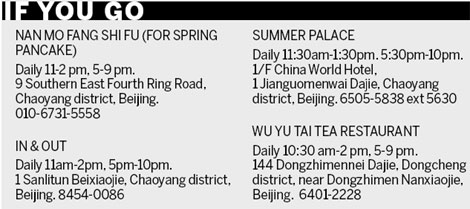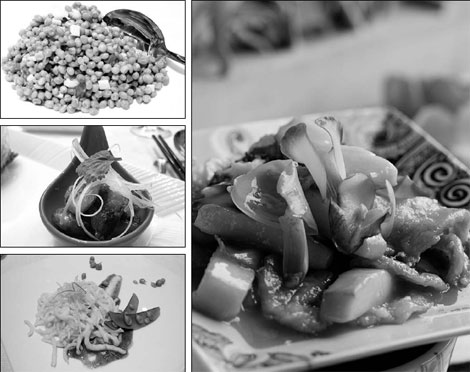Delicacies
Fresh flavors
Updated: 2011-04-03 07:59
By Ye Jun (China Daily)
|
Clockwise from right: Stir-fried orchid flower and erkuai, stir-fried mandarin fish, deep-fried shrimp and stir-fried green peas. Provided to China Daily |
Spring is the time to enjoy the natural freshness of food, Ye Jun reports.
Beijing
Many ancient Chinese people seem to have had a very detached attitude toward their deceased. Otherwise, China's Qingming Festival, or Tomb-sweeping Day, would not have also been known as the Cold Food Festival.
Although the tradition of preparing food beforehand and eating it cold on that day is now obsolete, it is time for special spring specialties to be introduced to the dining table.
In Beijing, like in many other parts of the country, an all-time classic spring food is chunjuan, or spring pancake, consumed especially between lichun, the 1st solar term of a year indicating the beginning of spring, which fell on Feb 4, and the Qingming Festival, which falls on March 5 this year.
The traditional belief holds that the vegetable sprouts will help people cater to the natural tendency of growing. So the spring pancake has a variety of tender vegetable sprouts wrapped inside, such as soybean sprouts, baby leek, spinach and shallot. These are complemented by flavorful fried egg and braised pork slices. The pancake wrapping is just like that of a Peking roast duck, only bigger.
Qingming Festival offers the chance to enjoy a variety of fresh foods. In Huaiyang cuisine, for example, it is the season when the Yangtze River has the best of "three delicacies" - reeves shad, knifefish and swellfish.
"Knifefish tastes much better before Qingming Festival than after it. The fish bone is soft now, but after the festival, it becomes hard," says Hou Xinqing, executive chef with Summer Palace Chinese Restaurant at China World Hotel.
A knifefish weighing 100 grams costs a startling 2,000-3,000 yuan each before Qingming Festival and requires a reservation. But prices will plummet due to the change in its taste later.
Hou's restaurant offers a mixture of Huaiyang, Shanghai and Cantonese cuisines, and emphasizes on light, healthy foods with original taste. Spring shrimps will be quick fried with oil and sweetened to make a crisp and tasty Huaiyang classic. White fish from Taihu Lake of Wuxi will be plain steamed to offer an exquisite texture.
The restaurant also provides fresh and tender spring vegetables such as caotou, "grass tip", malan tip and spring bamboo shoot. The vegetables will be plain fried to preserve their freshness. Spring bamboo shoot is stewed with longnose catfish, or braised, according to Hou.
Li Gang, owner of In & Out, one of Beijing's most popular Yunnan restaurants, gave a list of local wild vegetables available for spring. "Grass sprout" from Jianshui county looks and tastes like bamboo shoots. It is water-grown, two times thicker than chopsticks, and tastes tender and crisp. The vegetable is plain-fried, cold assorted, or fried with chicken slices.
Water coriander grows in the ponds of rainforests and is boiled with horsebean at the restaurant to offer a rich fragrance. It is also brined, dried and assorted with vinegar and small spicy chili to serve as a cold appetizer.
The flower bud of palm is fried with carrot and green bell pepper slices. Tasting slightly bitter but with a sweet aftertaste, the dish is used by local people to "relieve heat". Tree-grown tomato is roasted and peeled to mix with vegetables and made into a sour appetizer.
Yunnan's Jingpo ethnic group has an interesting way to make spring shrimps: Smash it in a wooden bucket and mix it with various spices. They also wrap the fresh shrimps in banana leaf, along with spices and seasoning, before grilling it to make it a classic "wrap grill".
The restaurant is also designing a "spring flower banquet", which is made with various flowers such as jasmine buds, orchid flower petals, chrysanthemum and cucumber flowers.
The first batch of spring green tea is picked and delivered to the market at the end of March. Wu Yu Tai Tea Restaurant uses this year's fresh tea to make dishes.
"This year's tea quality is better than previous years, because there has been plenty of rainfall before spring picking," says Liu Jia, the restaurant's in-house nutritionist.
Tea made from fresh biluochun, emerald spring spirals, is used to accompany peeled shrimp to enhance its taste and dispel the aftertaste of seafood. Jasmine tea is used to pair bird's nest with chrysanthemum. Liu says the dish is refreshing and helps to prevent dryness and thirst during the season. Fresh soaked leaves of Huangshan maofeng, furry tip, is fried with papaya, yam and baby cucumber for an extra tender and fresh delicacy.
"Spring vegetables are fresh, tender and flavorful," says Hou Xinqing. "Spring fish is fine, smooth and nutritious. They offer the most authentic natural flavors."

E-paper

Green mission
Tony blair believes China will take a leading role to fight climate change and cut emissions.
Stepping on to success
French connection
Generation gaps
Specials

Have you any wool?
The new stars of Chinese animation are edging out old childhood icons like Mickey Mouse and Hello Kitty.

Fill dad's shoes
Daughter and son are beginning to take over the family business of making shoes.

Virtual memorial
High-Tech touches to traditional tombsweeping festival help environment.

